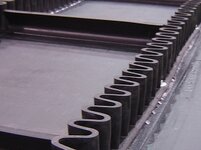sraomberts
Mechanical
- Jan 24, 2025
- 2
Got a good one for you guys. I am designing a conveyor to carry a shredded loose tobacco product, replacing an existing flimsy conveyor that has tracking and drive issues. The current system allows product to get under the belt, leading to buildup on the rollers and causing the belt to slip.
In my redesign, I’ve created a robust, washdown-compliant conveyor featuring:
For those experienced in conveyor design and fabrication, I have a couple of questions:
In my redesign, I’ve created a robust, washdown-compliant conveyor featuring:
- A polished stainless-steel running bed with bent-up edges that sandwich the belt between the skirting to prevent product from getting under the belt.
- Crowned pulleys at the head and tail for improved tracking.
- A snub roller to increase belt wrap around the drive pulley.
- Over 3" of belt tensioning adjustment, a significant improvement over the current 3/4" of existing tensioning.
For those experienced in conveyor design and fabrication, I have a couple of questions:
- Am I overthinking this?
- Will the take-up pulley between the two fixed idler rollers have any effect on tracking?
- Are my crowned pulleys even doing anything in this configuration?
- On the head end, is the additional tracking adjustment necessary for the idler pulley that uses a self-aligning bearings with 5 degrees of articulation?
Attachments
Last edited:

